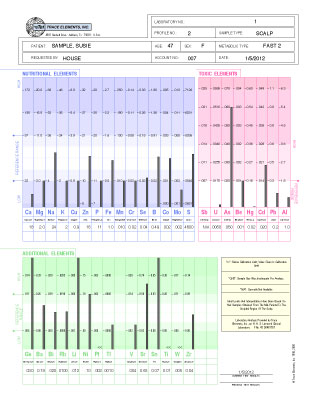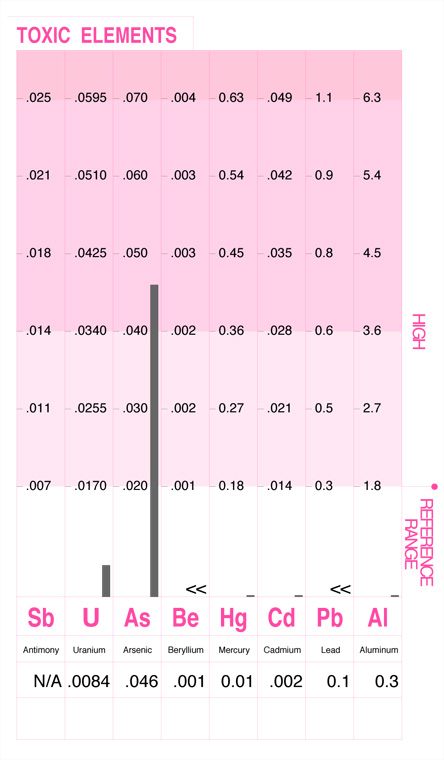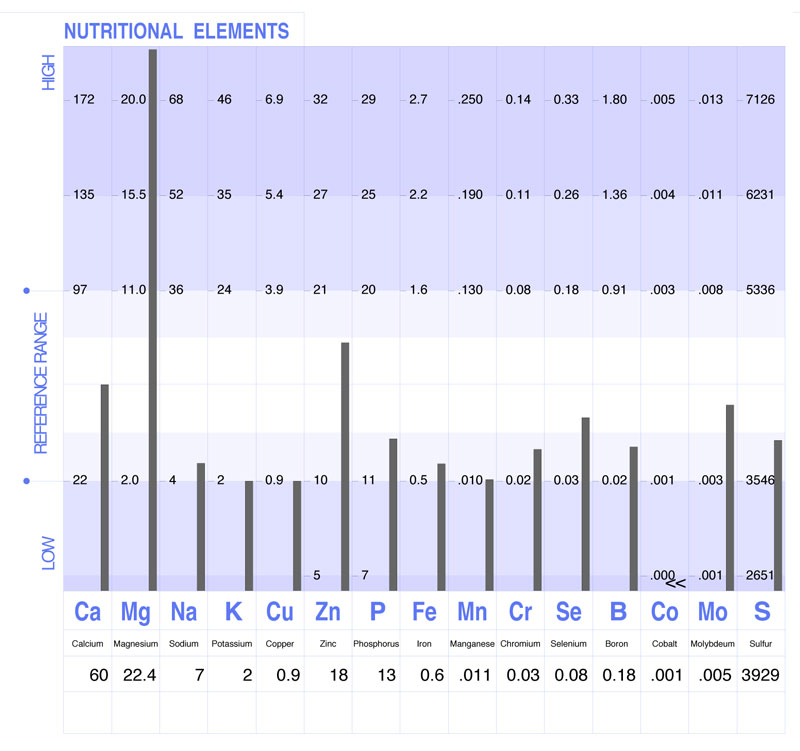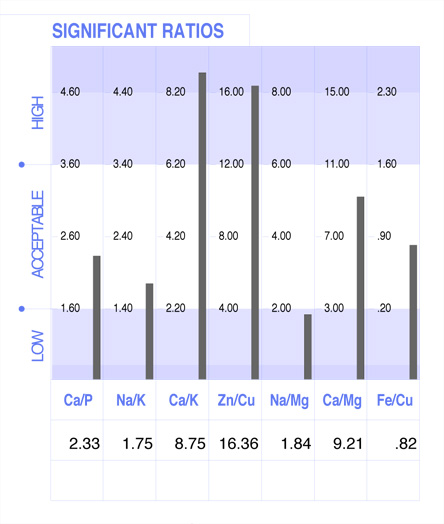Update: 21 December 2024
The hTMA Lab Report
A hair tissue mineral analysis (hTMA) is used worldwide by scientists and clinicians, and is considered a standard medical test for biomonitoring. Hair tissue is stable over time and provides several months of biochemical activity in a single sample. Obtaining the sample is inexpensive and non-invasive, and can be done without medical intervention.

Physical, biochemical and emotional stressors deplete the body of essential nutrients. Chronic illness develops in stages over time, and environmental illness is result of exposure to environmental toxicity. These combined health assaults result in the accumulation of toxins in tissue and disrupt normal body chemistry.
The hTMA lab test quantifies deficiences or excesses in essential mineral levels and ratios, and identifies toxic heavy metals of concern. A comprehensive lab report uses charts, graphs and supportive documentation to show an individual's unique metabolic status, and provides corrective recommendations to address mineral imbalances, reverse physical degeneration and revitalize cellular metabolism (energy).
- Progress Evaluation
- After 2 - 6 months, a progress retest is recommended. Often, the results are very different from the previous test. An updated, revised corrective protocol will then be recommended. Retesting promotes progressive improvement and helps address potential adverse reactions due to toxin removal and the readjustment of mineral ratios and levels. Progress retests are repeated until a healthy biochemical balance is achieved. The hTMA retest is the most biochemically revealing, cost effective method for monitoring detoxification progress.
Hair is recommended by the Environmental Protection Agency (EPA) as a preferred tissue for determining toxic heavy-metal exposure. A 1980 EPA report1 states that hair can be effectively used for biological monitoring of the highest priority toxic metals. Hair is one of the defining characteristics of mammals. Like other body tissues, it contains minerals that are deposited as the hair grows. hTMA uses the same analytical technology as is used for soil testing and testing of rock samples to detect mineral levels.
Hair growth begins inside the hair follicle. The only ‘living’ portion of the hair is found in the follicle. The hair that is visible is the hair shaft, which exhibits no biochemical activity and is considered ‘dead.’ The mineral composition within the cortex remain intact (indefinitely) as the hair continues to grow out. A one to 1-½" long sample of hair cut close to the skin provides information about the mineral activity in the hair that took place over the past three to four months, depending on the rate of hair growth.
hTMA Report (an example)
Four important areas of the report findings include:
Toxic Elements
The toxic elements section displays the results for each of the reported toxic elements. It is preferable that all levels be as low as possible and within the lower white section. Any test result that falls within the upper dark red areas should be considered as statistically significant, but not necessarily clinically significant. Further investigation may then be warranted to determine the possibility of actual clinical significance. The toxic minerals (heavy metals) are well-known for their interference upon normal biochemical function. These toxins are commonly found in the environment and therefore are present to some degree in all biological systems. However, these metals clearly pose a concern for toxicity when tissue accumulation occurs to excess.

Toxic Elements: This chart shows arsenic above the established reference range. Arsenic has been found high in some seafood obtained from coastal waters, particularly shellfish. Other sources include arsenic rich soils, herbicides, arsenic containing insect sprays, burning of arsenate treated building materials in fireplaces, coal combustion, and smelters.
Toxic Ratios
This section displays the relationships between the important nutritional elements and toxic metals. Each toxic metal ratio result should be in the upper white area of the graph, and the higher the better. Toxic ratios that fall within the darker red area may indicate an interference of that toxic metal upon the utilization of the nutritional element.
Every person is exposed to toxic metals to some degree. The retention of these toxic metals, however, is dependent upon the individual's susceptibility. The balance of the protective nutrient minerals within the body in relation to the heavy metals can frequently be the determining factor to this susceptibility. As an example, the accumulation of lead will have a more detrimental effect upon body chemistry when sufficient levels of calcium and iron are not available. By examining the toxic metal levels in relation to the protective minerals, the extent to which the heavy metals may be involved in abnormal chemistry can frequently be seen. This is done by examining the toxic ratios.

Toxic Ratios: This chart shows both a low Fe/Hg and a low Zn/Hg level. When iron and zinc levels within the body are sufficient, these nutrient minerals are able to produce an antagonistic or protective response to the adverse affects of mercury. However, when iron or zinc are low in relation to mercury, their protective action upon mercury may become markedly reduced.
Nutritional Elements
Extensively studied, the nutrient minerals have been well defined and are considered essential for many biological functions. They play key roles in such metabolic processes as muscular activity, endocrine function, reproduction, skeletal integrity and overall development. This section of the report shows nutritional mineral levels that may reveal moderate or significant deviations from normal. The white area of the graph's mineral levels represent the established reference ranges as determined from statistical analysis of healthy people. A mineral level that is outside the reference range can be identified.

Nutritional Elements: This chart shows excess magnesium. Magnesium is the fourth most abundant metal found in the body, and is essential for muscle relaxation, protein synthesis, nerve excitability and energy production on a cellular level. However, magnesium also has a sedating effect upon the body, and when in excess may contribute to a number of conditions, such as; low blood pressure, depression, fatigue, dizziness, craving for salt, muscle weakness, decreased mental alertness, lowered body temperature.
Significant Ratios
The significant ratios section displays the important nutritional mineral relationships. Mineral relationships (balance) is as important, if not more so, than the individual mineral levels. The ratios reflect the critical balance that must be constantly maintained between the minerals in the body for healthy metabolic function and optimal cellular energy production.
Continuing research indicates that metabolic dysfunctions occur not necessarily as a result of a deficiency or excess of a particular mineral level, but more frequently from an abnormal balance (ratio) between the minerals. Due to this complex interrelationship between the minerals, it is extremely important that imbalances be determined. Once these imbalances are identified, corrective therapy may then be used to help re-establish a more normal biochemical balance.

Significant Ratios: This chart shows a high Ca/K ratio. High calcium relative to potassium will frequently indicate a trend toward hypothyroidism (under-active thyroid). The mineral calcium antagonizes the retention of potassium within the cell. Since potassium is necessary in sufficient quantity to sensitize the tissues to the effects of thyroid hormones, a high Ca/K ratio would suggest reduced thyroid function and/or cellular response to thyroxine. If this imbalance has been present for an extended period of time, the following symptoms associated with low thyroid function may occur; fatigue, depression, dry skin, over-weight tendencies, constipation, cold sensitivity.
References
- Jenkins, D. (1980). Biological Monitoring of Toxic Trace Metals - Vol. II, Toxic Trace Metals in Plants and Animals of the World - part I. (EPA600380090). Environmental Protection Agency, Washington, D.C.